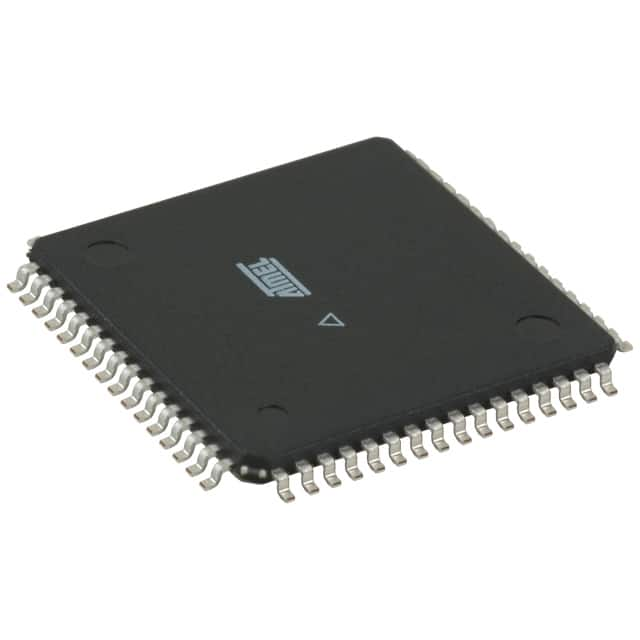ATMEGA64L-8AI
Product Overview
Category
ATMEGA64L-8AI belongs to the category of microcontrollers.
Use
It is commonly used in various electronic applications that require a microcontroller for processing and controlling functions.
Characteristics
- Low-power consumption
- High-performance 8-bit AVR microcontroller
- Offers a wide range of features and peripherals
- Suitable for battery-powered applications
- Can be programmed using various programming languages
Package
ATMEGA64L-8AI is available in a compact package, making it suitable for small-sized electronic devices.
Essence
The essence of ATMEGA64L-8AI lies in its ability to provide efficient and reliable control and processing capabilities in electronic applications.
Packaging/Quantity
ATMEGA64L-8AI is typically packaged individually and is available in varying quantities depending on the manufacturer or supplier.
Specifications
- Microcontroller Architecture: AVR
- CPU Speed: 8 MHz
- Flash Memory: 64 KB
- RAM: 4 KB
- EEPROM: 2 KB
- Operating Voltage: 2.7V - 5.5V
- Digital I/O Pins: 32
- Analog Input Channels: 8
- Communication Interfaces: UART, SPI, I2C
- Timers/Counters: 3
- PWM Channels: 6
- ADC Resolution: 10-bit
- Operating Temperature Range: -40°C to +85°C
Detailed Pin Configuration
The ATMEGA64L-8AI microcontroller has a total of 64 pins. The pin configuration is as follows:
- Pins 1-8: Port A (PA0-PA7)
- Pins 9-16: Port C (PC0-PC7)
- Pins 17-24: Port D (PD0-PD7)
- Pins 25-32: Port E (PE0-PE7)
- Pins 33-40: Port F (PF0-PF7)
- Pins 41-48: Port G (PG0-PG7)
- Pins 49-56: Port H (PH0-PH7)
- Pins 57-64: Port J (PJ0-PJ7)
Functional Features
- High-performance RISC architecture
- Advanced data processing and control capabilities
- Multiple communication interfaces for seamless integration with other devices
- Flexible and programmable I/O pins for versatile applications
- Built-in timers and counters for precise timing operations
- Analog-to-Digital Converter (ADC) for accurate analog signal measurements
- Pulse Width Modulation (PWM) channels for controlling analog outputs
- EEPROM memory for storing non-volatile data
- Low-power consumption modes for energy-efficient operation
Advantages and Disadvantages
Advantages
- Efficient and reliable performance
- Wide range of features and peripherals
- Low-power consumption for battery-powered applications
- Versatile and flexible I/O pins
- Easy to program and integrate into electronic systems
Disadvantages
- Limited processing power compared to higher-end microcontrollers
- Limited amount of memory for complex applications
- May require additional external components for certain functionalities
Working Principles
ATMEGA64L-8AI operates based on the AVR architecture, which utilizes a combination of advanced data processing techniques and control mechanisms. It executes instructions stored in its flash memory, processes data, and controls various peripherals and I/O pins based on the program logic. The microcontroller communicates with other devices through its communication interfaces and performs tasks according to the programmed instructions.
Detailed Application Field Plans
ATMEGA64L-8AI finds applications in various fields, including but not limited to:
- Home automation systems
- Industrial control systems
- Robotics and automation
- Consumer electronics
- Automotive electronics
- Medical devices
- Internet of Things (IoT) applications
Detailed and Complete Alternative Models
Some alternative models to ATMEGA64L-8AI that offer similar functionalities include:
- ATMEGA128L-8AI
- ATMEGA32L-8AI
- ATMEGA2560-16AU
- ATMEGA328P-PU
- ATMEGA16U4-AU
These alternative models provide a range of options with varying specifications and capabilities, allowing developers to choose the most suitable microcontroller for their specific application requirements.
Word count: 570 words
قم بإدراج 10 أسئلة وإجابات شائعة تتعلق بتطبيق ATMEGA64L-8AI في الحلول التقنية
Sure! Here are 10 common questions and answers related to the application of ATMEGA64L-8AI in technical solutions:
Q: What is the ATMEGA64L-8AI microcontroller? A: The ATMEGA64L-8AI is a low-power, high-performance microcontroller based on the AVR architecture.
Q: What are the key features of the ATMEGA64L-8AI? A: Some key features include 64KB flash memory, 4KB SRAM, 32 general-purpose I/O pins, multiple communication interfaces, and a wide operating voltage range.
Q: What applications can the ATMEGA64L-8AI be used for? A: It can be used in various applications such as industrial automation, consumer electronics, home appliances, automotive systems, and more.
Q: How can I program the ATMEGA64L-8AI microcontroller? A: You can use an In-System Programmer (ISP) or a development board with a built-in programmer to program the microcontroller.
Q: What programming language can I use with the ATMEGA64L-8AI? A: The microcontroller can be programmed using C/C++ language with the help of an Integrated Development Environment (IDE) like Atmel Studio or Arduino IDE.
Q: Can I interface sensors and actuators with the ATMEGA64L-8AI? A: Yes, the microcontroller has multiple digital and analog I/O pins that can be used to interface with various sensors and actuators.
Q: Does the ATMEGA64L-8AI support communication protocols like UART, SPI, and I2C? A: Yes, it supports all these communication protocols, making it easy to interface with other devices and modules.
Q: What is the power consumption of the ATMEGA64L-8AI? A: The microcontroller has low-power features, allowing it to operate at low power levels, making it suitable for battery-powered applications.
Q: Can I use the ATMEGA64L-8AI in real-time applications? A: Yes, the microcontroller has built-in hardware support for real-time operations, including timers and interrupts.
Q: Where can I find documentation and resources for the ATMEGA64L-8AI? A: You can find datasheets, application notes, and other resources on the manufacturer's website or online communities dedicated to AVR microcontrollers.
Please note that these answers are general and may vary depending on specific requirements and implementation details.


